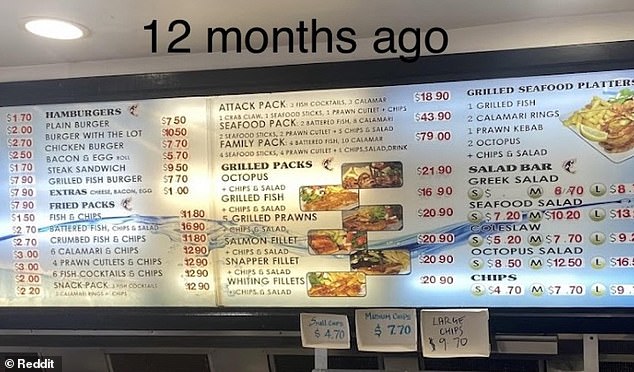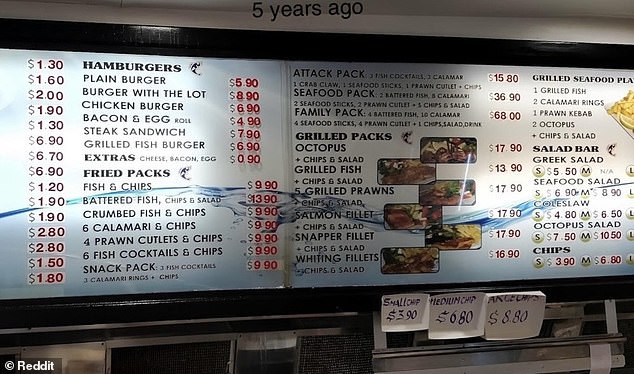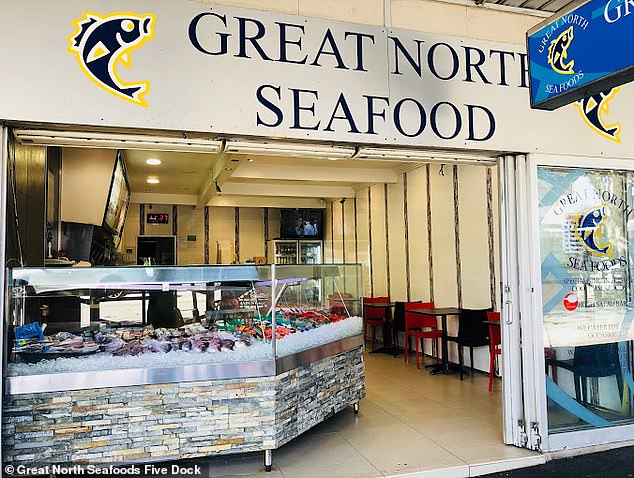The sobering reality of Australia’s dramatically rising food prices seen on the menu board of Great North Seafood in Sydney’s Five Dock
Photos of a menu from the same takeaway shop have over time given the lie to the old adage ‘cheap as chips’.
The photos showing the full menu at Great North Seafood in the western Sydney suburb of Five Dock – taken at intervals of two months, a year and five years – have revealed a stunning increase in prices.
The three photos were posted on the social media platform under the headline ‘Forget housing, enter the fishing industry for an investment’ Reddit for easy comparison by the Pinkfatrat account holder on Monday.
The snapshots stunningly show that prices have risen by 14 percent in just ten months, with a family pack costing $79 a year ago but rising to $90 in the photo from two months ago.

These two photos of the takeaway’s blackboard menu show the astonishing price increase this year in just ten months
A regular burger has risen from €7.50 to €9.20 and a seafood package has risen from €43.90 to €49.90 in the same ten-month period.
Five years ago, the family package cost $68.00, the burger package $5.90 and the seafood package $36.90, putting this year’s rapid increases into sharp context.
Many of the commentators were surprised at the steep ascents.
“I remember in high school I had $2 worth of chips and that was a whole chip basket’s worth,” one person said.
‘$90 for a family package?! WHAT THE F***! Are you OP in a rural area?’ another wrote.
‘Everything is being overhauled. Eventually it will get so high that people will just stop eating out,” said another comment.
A number of explanations have been given for the explosively rising prices.

This shot, taken five years ago at western Sydney fish and chip shop Great North Seafood, shows the pace of price increases has increased alarmingly
“This is just a huge run-on effect of companies seeing prices rise in other places and thinking they’re leaving money on the table if they don’t do it,” one commenter wrote.
“Commercial landlords are slowly strangling tenants with rent increases, but no one ever talks about it,” said another.
“Supplier production is literally increasing every two weeks,” wrote another.
‘Milk, cheese everything. Energy, gas and water are ridiculous for companies.
“Small businesses are raising prices because it literally reflects the continued increases. It’s getting to a point where it’s like, how far can this go until no one can afford to pay for this anymore.”
Shop owner Leang Eng, who took over Great North Seafood last year, confirmed the latest statement.
She said the price of “everything” – from food to electricity, rent and even workers’ wages – has risen, forcing her to raise prices even though it was “very difficult”.
“Some of the fish, the fillets, all the stuff goes up. We have had to increase prices at least 10 to 20 percent more on top of the previous increases,” she said. news.com.au.

The store’s owner said it was “very difficult” to raise prices, but the cost of everything was going up
In October it was announced that the consumer price index had risen 5.4 percent for the September quarter, which was barely lower than the 6 percent in the June quarter.
However, another set of figures, also from the Australian Bureau of Statistics, showed much higher price increases in individual categories of goods and services.
The conflict between Israel and Hamas has fueled fears that the price of crude oil could rise, leading to motorists in Sydney paying $2.40 per liter for 95 octane unleaded.
Bread and cereal costs rose 8.9 percent, while electricity bills rose 18 percent and gas prices rose 12.7 percent.
The housing crisis is also getting worse, with rents in Brisbane rising 9.5 per cent in the past year, compared to Sydney’s 8.6 per cent increase.
Costs for insurance and financial services also increased by 8.6 percent.
